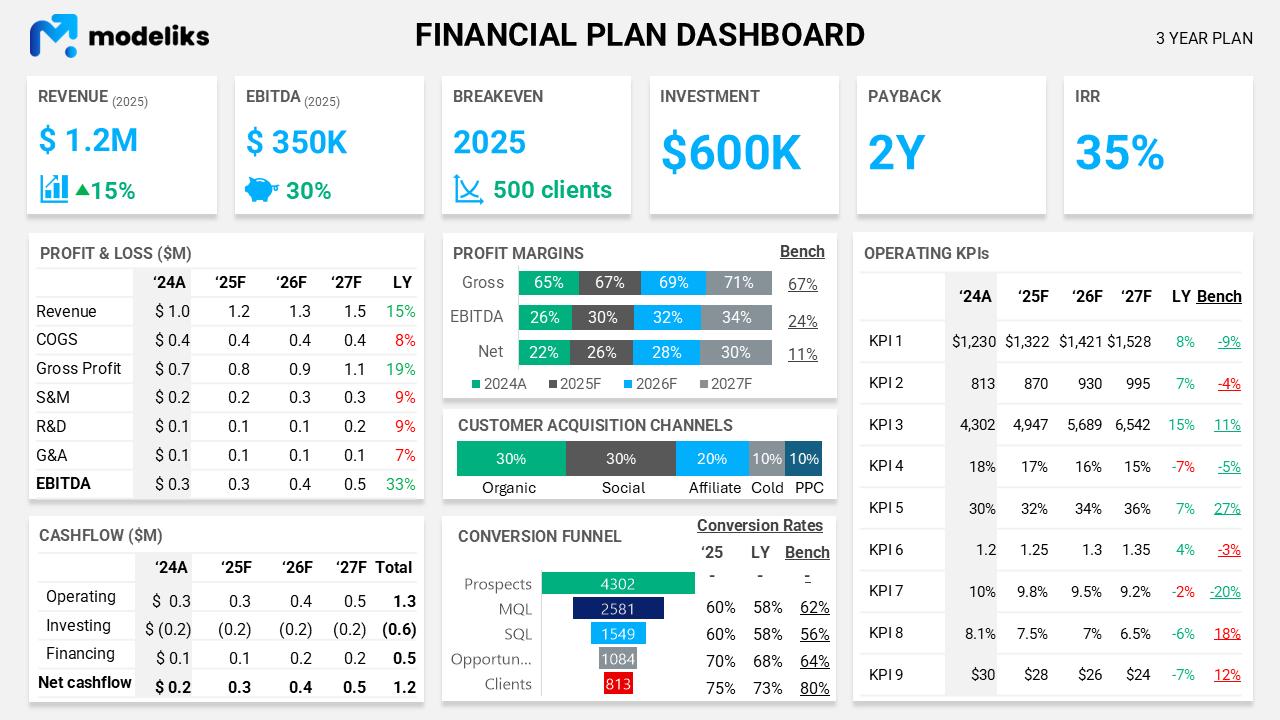Our Virtual Reality Game Development Financial Model Structure covers all the essential aspects you need to consider when starting or scaling a Virtual Reality Game Development business. By following this structure, you can better understand your revenue streams, costs, and assets, helping you optimize profitability and strategically plan for growth.
Entering the Virtual Reality (VR) Game Development market requires a well-structured financial planning approach. This model comprises an overview of typical revenues, direct costs, employees, expenses, and assets you need to consider when launching or expanding your VR Game Development business. Understanding these elements might open avenues for new and lucrative revenue streams; however, it is crucial to conduct thorough research before making decisions. Although the potential for success is significant, you must also account for the risks involved. This approach can help sustain and grow your enterprise successfully, because a comprehensive understanding of the financial landscape is essential.
The Virtual Reality Game Development Financial Model Structure
Revenues
- Game Sales: Revenue generated from selling VR games directly to consumers. Calculated as the number of games sold multiplied by the price per game.
- In-App Purchases: Revenue from micro-transactions within the game. Estimated as the average transaction value multiplied by the number of transactions.
- Subscription Plans: Ongoing revenue from users subscribing to the game or service. Calculated by multiplying the number of subscribers by the subscription fee.
- Advertising: Income from displaying ads within the VR games. Measured as the number of ad impressions times the cost per impression.
- Licensing: Revenue from licensing game technology or content to third parties. Determined by the licensing fee times the number of licenses sold.
- Merchandising: Earnings from selling merchandise related to the game. Estimated as the number of merchandise items sold multiplied by the item price.
- Partnerships: Revenue from strategic partnerships with other companies. The calculation method varies depending on the agreement specifics.
Cost of Goods Sold
- Development Tools: The cost of software and tools needed for game development can be significant.
- Server Costs: Expenses related to hosting multiplayer games and player data, essential for seamless gameplay.
- Royalty Fees: Payments required for using certain intellectual properties can add to the budget.
- Marketing Distribution: Costs associated with distributing the game digitally or physically, often fluctuating.
- Payment Gateway Fees: Charges for processing in-game and online payments, which can vary widely.
Employees
- Game Developers: Responsible for creating the game’s functionality, visual elements, and overall performance, playing a crucial role in development.
- Designers: Focus on the aesthetic aspects of the game, including character and environment design, which are vital.
- Quality Assurance Testers: Ensure the game is free from bugs and glitches before release by being meticulous.
- Marketing Specialists: Develop and execute marketing strategies to promote the game, significantly impacting its success.
- Project Managers: Oversee the development process and ensure timely delivery of milestones, even when challenges arise.
Operating Expenses
- Rent: Cost for office space leased for the team.
- Utilities: Expenses for electricity, water, and internet service.
- Salaries: Employee compensation packages, including benefits, are crucial.
- Software Licenses: Recurring costs for software used in development can also be significant.
- Marketing: Funds allocated for advertising, PR, and promotions.
- Travel: Costs associated with business travel for conferences or meetings.
- Legal Fees: Charges for legal counsel and compliance requirements can add up.
- Insurance: Premiums for business insurance policies.
- Office Supplies: Purchasing supplies needed for everyday office function.
- Training: Investment in professional development opportunities for staff, vital for growth.
Assets
- Office Equipment: Computers, VR headsets, and other technological devices are essential.
- Intellectual Property: Patents and copyrights related to game development are vital.
- Software Infrastructure: Proprietary or licensed software for game creation plays a crucial role.
- Furniture: Chairs, desks, and other fixtures are necessary for the office because comfort can enhance productivity.
Funding Options
- Venture Capital: Investment from firms specializing in high-potential startups.
- Angel Investors: Private individuals investing in exchange for equity.
- Crowdfunding: Raising small amounts of money from a large group of people.
- Bank Loans: Borrowing funds through traditional financial institutions.
- Government Grants: Non-repayable funds offered to support innovative businesses.
Driver-based Financial Model for Virtual Reality game development
A driver-based financial model for Virtual Reality game development is essential; however, a truly professional model relies on the operating KPIs (aka “drivers”) that are relevant to this industry. Although there are many factors to consider, the importance of these drivers cannot be overstated.
Operating KPIs
- User Acquisition Cost (UAC): Average cost to acquire a new customer.
- Monthly Active Users (MAU): The number of unique users engaging with the game monthly.
- Retention Rate: Percentage of users who continue to use the game over a given period.
- Average Revenue Per User (ARPU): Average amount of money made from each user.
- Churn Rate: Percentage of users who stop using the game in a given period.
- Customer Lifetime Value (CLTV): Total revenue expected from a customer over their lifetime.
- Development Cycle Time: Time taken from the start of game development to launch.
- Bug Detection Rate: Frequency of discovering issues during the testing phase.
Driver-based financial planning is a process of identifying the key activities (also known as ‘drivers’) that have the highest impact on your business results; however, building your financial plans based on those activities is crucial. It allows you to establish relationships between the financial results and the resources you need to achieve those results, like people, marketing budgets, equipment, etc. Although this process is complex, it is essential for optimizing your business performance.
If you wish to learn more about driver-based financial planning (which is increasingly recognized as a sound method for strategizing), consider watching the founder of Modeliks elucidate this concept in the video below. However, one might question the efficacy of such an approach. Although it offers numerous advantages, some still remain skeptical. This is primarily because traditional methods have long dominated the landscape.
Need a business plan?
Create one with Modeliks AI in the next hour!
AI powered business planning for Startups and SMEs.
The Financial Plan Output
The objective of the financial forecast outputs should ideally enable you, your management, board, or investors to quickly grasp how your Virtual Reality Game Development business will perform in the future. You can gain reassurance that the plan is well thought through, realistic, and achievable. Furthermore, you must comprehend what investment is necessary to implement this plan and the anticipated return on the investment. To attain these goals, here is a one-page template on how to effectively present your financial plan.

In addition to this one-page summary of your plan, you will require the three projected financial statements:
- Profit and Loss
- Balance Sheet
- Cash Flow Statement
Virtual Reality Game Development Financial Model Summary
A professional Virtual Reality Game Development financial model can help you think through your business. It will identify the resources you need to achieve your targets, set goals, measure performance, raise funding, and make confident decisions—this is crucial for managing and growing your business. However, it is essential to approach these aspects strategically, because the success of your venture often hinges on careful planning. Although challenges may arise, having a solid financial foundation can mitigate risks and guide your decisions effectively.
If you need help with your financial plan, try Modeliks , a financial planning solution for SMEs and startups or contact us at contact@modeliks.com and we can help.
Author:
Blagoja Hamamdjiev
, Founder and CEO of
Modeliks
, Entrepreneur, and business planning expert.
In the last 20 years, he helped everything from startups to multi-billion-dollar conglomerates plan, manage, fundraise, and grow.

TAKE MODELIKS FOR A SPIN
Not sure which plan?
Start with a 15 days free trial.
You will have access to the full functionality of Modeliks. The only restriction in the free trial is that you cannot download or share your business plan outside Modeliks. Credit card is not required to subscribe for the free trial.






